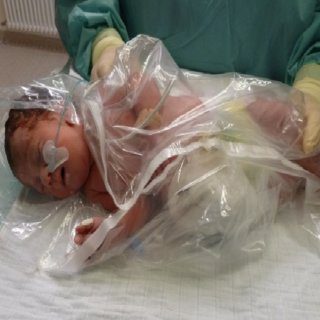Contents
Laparoschisis
Laparoschisis, or gastroschisis, refers to a rare congenital malformation of the abdominal wall. It results in an exit of the intestine outside the abdominal cavity. Immediate care after childbirth is necessary.
What is laparoschisis?
Definition of laparoschisis
Laparoschisis, also called gastroschisis, is a congenital malformation (present from birth). It is characterized by incomplete closure of the abdominal wall, most often to the right of the navel (umbilicus). Through this opening, a large part of the intestine comes out of the abdominal cavity.
Laparoschisis is an isolated anomaly. This characteristic makes it possible to distinguish it from another malformation in the abdomen: the omphalocele. This results in an exit of the intestine at the level of the umbilical cord and is frequently accompanied by other malformations, in particular of the heart.
Cause du laparoschisis
Laparoschisis is a developmental anomaly. Its exact origin remains unknown to this day. No family background or risk factor has yet been identified.
Diagnosis of laparoschisis
The diagnosis of laparoschisis is carried out prenatal during the pregnancy follow-up ultrasound examination. It is followed by more regular monitoring of pregnancy and specific support for childbirth. Specialized care is necessary from the birth of the baby.
Laparoschisis is a rare malformation. Its incidence is estimated between 1 birth in 4000 to 1 birth in 10.
Symptoms of laparoschisis
Opening of the abdominal wall
Laparoschisis is characterized by an abnormal cleft in the abdominal wall. It is due to a lack of closure of the abdominal wall, most often to the right of the navel.
Exit of the intestine outside the abdominal cavity
Through the slit in the abdominal wall, a large part of the intestine comes out.
Risk of damage to the intestine
Laparoschisis presents a risk of complications, and in particular a risk of lesions in the intestine. During pregnancy, it is no longer contained in the abdominal cavity and bathes in amniotic fluid. This biological fluid can damage the intestine. It may appear dilated, clumped, and thickened.
Lesions in the intestine can promote:
- the occurrence of digestive problems;
- the development of scar tissue;
- intestinal obstruction, that is, partial or total blockage of the intestine;
- infection after childbirth.
Management of laparoschisis
Regular monitoring of pregnancy
After prenatal diagnosis of laparoschisis, the development of the fetus is monitored on a regular basis to identify any risk of complications. Childbirth can be anticipated if the situation requires it.
Preparation for childbirth
The laparoschisis has no influence on the delivery route. On the other hand, childbirth must take place in the presence of a specialized medical team. Immediate care of the infant is necessary.
Support from childbirth
At birth, the baby is taken care of immediately. A sterile dressing is applied to the organs protruding from the abdominal wall. The absence of associated anomalies is verified. The infant is infused and receives the necessary care.
Surgery is performed as soon as possible to place the organs back inside the abdominal cavity and then close the wall of the abdomen. Left empty during pregnancy, the abdominal cavity is often too small to accommodate all of the contents of the abdomen. A gradual reintegration over a few days to a few weeks is sometimes necessary before practicing the closure of the abdominal wall.
The child is hospitalized and placed on parenteral (intravenous) nutrition until his intestines return to normal function. The hospitalization time varies from one to a few months depending on the recovery of the baby.
Prevent laparoschisis
To date, there is no prevention for laparoschisis because its origin remains unknown. Research continues.










